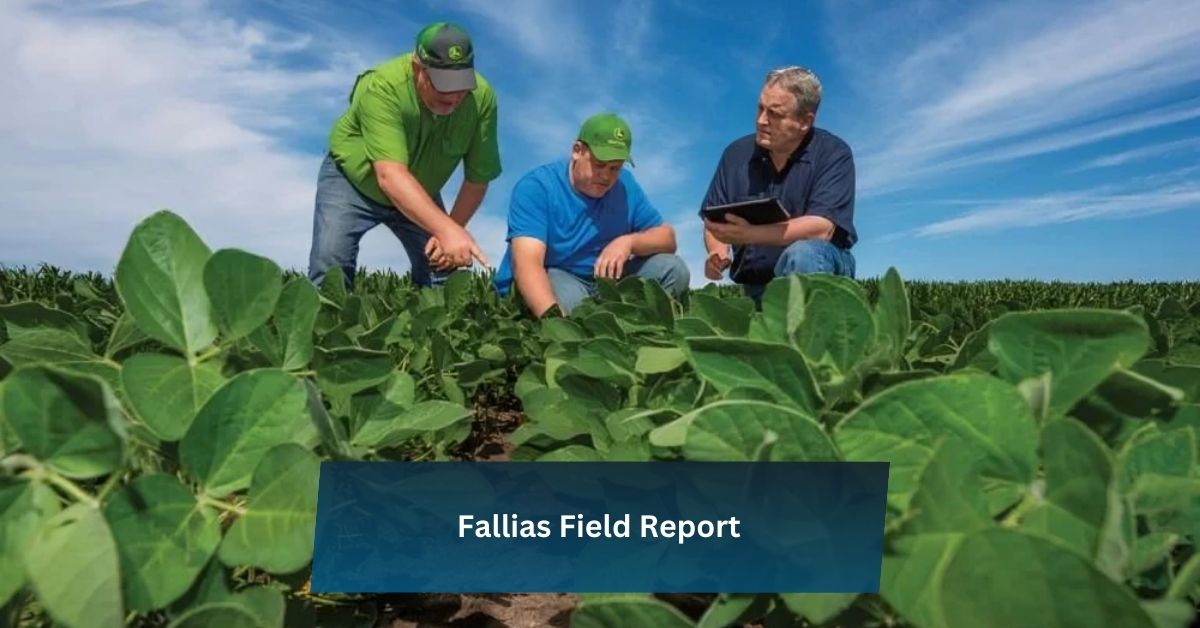The “Fallias Field Report” has become an essential term and tool in various professional and research contexts. From environmental studies to on-the-ground data collection, the Fallias Field Report plays a critical role in gathering, analyzing, and reporting information in a structured, reliable manner. This guide provides a thorough breakdown of the Fallias Field Report, its uses, and its significance, especially for those in the USA seeking clear and actionable insights into its implementation.
The Fallias Field Report is a detailed document that includes important sections like an introduction, methodology, observations, analysis, conclusions, and recommendations. It explains why a study was done, how data was collected, what was found, and what those findings mean. This report helps others understand and use the information gathered from the field.
In this article, we will cover the purpose of the Fallias Field Report, its core components, best practices for writing and compiling an effective report, and its relevance across different sectors. With a comprehensive look into these aspects, we aim to help you produce accurate, well-rounded reports.
What Is A Fallias Field Report?
The Fallias Field Report is a structured document used to collect and analyze data in a specific environment or location. Commonly used in research, environmental studies, and other fields requiring detailed field observations, this report functions as both a record and a tool for evaluating data obtained in real-world settings. It serves as a crucial resource for identifying trends, documenting environmental conditions, and making informed decisions based on observed data.
Key Objectives Of The Fallias Field Report
The Fallias Field Report provides a structured way to record observations, analyze findings, and present conclusions. Its main objectives include:
- Data Collection and Analysis: Gathering accurate, field-specific data on a topic, phenomenon, or location.
- Environmental Monitoring: Documenting the current state of a specific area for monitoring purposes.
- Decision-Making Support: Providing reliable data to assist stakeholders in making informed decisions.
- Reporting Findings: Summarizing information for publication, further research, or policy development.
The Fallias Field Report is indispensable for anyone looking to capture real-world data in an organized and methodical way.
Why The Fallias Field Report Is Important In Environmental Studies
Environmental studies often require detailed, on-site observations that cannot be substituted with lab or theoretical data. The Fallias Field Report provides a structured means of reporting this information, helping to bridge the gap between raw data and actionable insights. For environmental professionals, these reports are essential for:
- Assessing Environmental Impact: By recording environmental changes over time, these reports aid in identifying and quantifying environmental impacts.
- Tracking Conservation Efforts: Field reports provide insight into the effectiveness of conservation methods, highlighting what is working and what may need adjustment.
- Guiding Policy and Research: When shared with policymakers or academic institutions, field reports offer the data needed to make informed policy or research decisions.
Core Components Of The Fallias Field Report
Certainly! The Core Components of the Fallias Field Report refer to the essential sections that make up the report, each serving a specific purpose in structuring and presenting collected data effectively. By including each of these components, you ensure the report is thorough, clear, and professional. Here’s a breakdown of each part:
1. Introduction And Purpose
- This section gives readers a quick overview of what the report is about. It explains why the study or observation was done, setting the context for the report.
- It usually includes the objectives of the report and a brief description of the area or subject of study, so the reader understands the reason behind the fieldwork.
2. Methodology
- The methodology explains how the data was collected. This includes the tools, techniques, and any specific steps used to gather information.
- Detailing the methodology helps others understand and potentially replicate the work. It’s also a place to justify why certain methods were chosen and discuss any limitations or challenges.
3. Observations
- Observations provide the raw data collected in the field, arranged in a clear and structured way.
- This section often includes descriptive notes, data tables, photographs, or maps to document what was seen, measured, or experienced directly in the field.
- Providing a detailed observations section helps readers understand the field conditions and the specific aspects observed.
4. Analysis
- In this part, the raw observations are interpreted to find trends, patterns, or unusual findings that may be significant.
- The analysis connects back to the initial purpose and objectives, helping readers understand what the data means in relation to the study. It’s where the main insights and interpretations come into play.
5. Conclusions And Recommendations
- This section is where the key findings are summarized. It answers whether the initial goals or hypotheses were met, offering a clear summary of the results.
- Additionally, recommendations are provided here. These are actionable insights or suggestions based on the findings, potentially guiding future studies, field practices, or even policies.
6. Appendices And References
- Appendices hold any extra information or data that supports the main report, such as additional tables, maps, or raw data that may not fit within the main body.
- References cite any sources, studies, or previous reports that were used as a basis for the methodology or analysis, allowing others to find background information or verify sources.
Each of these components plays an important role in creating a comprehensive Fallias Field Report that is informative, clear, and structured, making the data accessible and actionable for readers.
Tips For Writing An Effective Fallias Field Report
Creating a compelling Fallias Field Report requires more than just gathering data; it involves clear organization, precise wording, and thoughtful analysis. Here are some tips for producing a top-notch report:
- Use Clear and Simple Language: A Fallias Field Report should be straightforward and accessible. Avoid overly technical jargon, and focus on presenting information in a way that’s easy to understand.
- Provide Detailed Observations: Comprehensive observations are the backbone of a field report. Be specific about locations, times, and other pertinent details to enhance accuracy.
- Be Objective and Unbiased: Field reports should document what is observed without inserting personal opinions. Stick to objective descriptions to maintain the report’s integrity.
- Visualize Data: Where possible, use charts, graphs, or photographs to illustrate findings. Visual aids can make complex information easier to digest and more engaging.
- Summarize Key Findings in the Conclusion: Reiterate the most important findings concisely in the conclusion. This helps readers quickly grasp the report’s essence without needing to read the entire document.
- Proofread for Accuracy: Double-check all data points, units, and other critical details for accuracy before submission.
Applications Of The Fallias Field Report In Various Sectors
While environmental studies often make use of the Fallias Field Report, it is valuable in other sectors as well:
- Agriculture: Agricultural researchers use field reports to track crop growth, soil conditions, and other variables. These reports are invaluable for developing better farming techniques and sustainable practices.
- Public Health: In public health, field reports assist in tracking disease outbreaks and health conditions within a community. Such reports help health authorities plan interventions and improve public health policies.
- Geology and Earth Sciences: Geologists employ field reports to document rock formations, soil samples, and other geological data. These reports aid in understanding natural resource distribution and environmental stability.
- Education and Training: Field reports are also common in educational settings, where they teach students about the importance of detailed data collection and objective reporting. They are frequently used in practical, hands-on learning activities.
Challenges In Compiling A Fallias Field Report
While Fallias Field Reports are immensely beneficial, they also come with their own set of challenges:
- Environmental Variables: Weather, climate, and other environmental conditions can impact data collection, often necessitating adjustments to the planned methodology.
- Data Accuracy: Ensuring data accuracy in the field can be difficult, especially when using untested tools or techniques. Accuracy is critical for reliable findings.
- Resource Limitations: Field reports require resources such as time, funding, and equipment, which can be limited depending on the project’s scope.
- Subjectivity Risks: Field reports must maintain objectivity to retain credibility. Bias or subjective interpretations can affect the report’s reliability.
Best Practices For Using Technology In The Fallias Field Report
Technology can significantly enhance the quality and accuracy of Fallias Field Reports. Here’s how:
- GPS and Mapping Tools: GPS devices and mapping software are crucial for accurately recording locations and plotting data.
- Digital Data Collection: Smartphones and tablets equipped with data collection apps simplify gathering and organizing information directly in the field.
- Drones for Aerial Data: Drones provide an aerial perspective, especially useful in environmental studies, agriculture, and other fields where large areas need to be surveyed.
- Data Analysis Software: Analytical software, such as GIS (Geographic Information Systems), can help interpret spatial data more effectively, revealing trends not easily seen from ground-level observations.
FAQ’s
1. What Is The Main Purpose Of The Fallias Field Report?
The Fallias Field Report’s main purpose is to gather and analyze data from field observations, typically in environmental studies, research, and practical applications. It serves as a structured way to document, interpret, and report findings from real-world settings.
2. How Do I Ensure Accuracy In My Fallias Field Report?
To ensure accuracy, use reliable tools, follow a structured methodology, and avoid subjective interpretations. Proofread data points and utilize technology such as GPS and data analysis software to validate your observations.
3. Can The Fallias Field Report Be Used In Industries Outside Of Environmental Studies?
Yes, the Fallias Field Report is widely used in various sectors, including agriculture, public health, geology, and education, to document and analyze real-world data.
4. What Are Some Common Challenges In Preparing A Fallias Field Report?
Challenges include environmental factors, data accuracy, resource limitations, and the risk of subjective reporting. Preparing in advance and using reliable equipment can help mitigate these challenges.
5. How Often Should Fallias Field Reports Be Updated?
The frequency of updates depends on the field and purpose. In ongoing environmental studies, for example, frequent updates may be necessary to track changes over time.
6. Is There A Standardized Format For The Fallias Field Report?
While there is no universally standardized format, most field reports include sections such as the introduction, methodology, observations, analysis, conclusions, and references.
Conclusion:
The Fallias Field Report remains a vital tool across multiple disciplines, especially in environmental research, agricultural studies, and public health. By offering a structured approach to data collection, analysis, and reporting, it helps professionals make informed, data-driven decisions and enhances our understanding of the world around us. Whether you’re a seasoned researcher or a novice, mastering the art of creating a comprehensive Fallias Field Report is a valuable skill that can significantly impact the quality of your work.















Leave a Reply